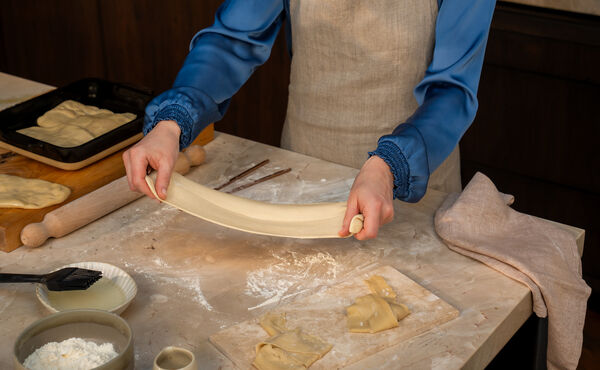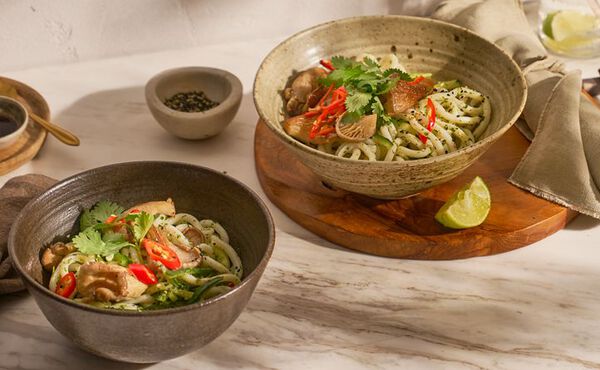Disse nudlene med syltede grønnsaker og chiliolje smaker nydelig og er morsomme å lage. Dessuten kan de varme deg på kalde kvelder.

Ingredienser:
Til de syltede grønnsakene:
-
1/4 kinakål kuttet i små biter
-
1 gulrot skåret i små terninger
-
½ agurk skåret i små terninger
-
60 ml riseddik
-
1 ss sukker
-
1/2 ss salt
Til nudlene:
-
¼ ts salt
-
100 ml romtemperert vann, eller mer om nødvendig
-
200 g mel
-
100 ml vegetabilsk olje
-
2 stilker vårløk (den grønne delen, skåret i ringer)
-
2 ts chilipulver
-
1 ts finmalte Sichuan-pepperkorn
-
2 ss soyasaus
Slik gjør du:
Til de syltede grønnsakene:
-
Legg kinakål, gulrøtter og agurk i et stort rent glass.
-
Hell riseddik, sukker og salt direkte i glasset.
-
Sett på tett lokk og rist godt for å løse opp sukkeret og saltet så godt som mulig.
-
Sett glasset i kjøleskapet og la det stå der i minimum noen timer. Smaken blir bedre etter en dag.
Biang biang-nudler:
-
Løs opp saltet i vannet. Hell melet i kjøkkenmaskinens bolle, og sett på deigkroken. Sett mikseren på lav hastighet, og tilsett vannet sakte i en tynn stråle langs kanten av bollen. Bland på lav hastighet til det dannes en jevn, sammenhengende deig. Dette skal ikke ta mer enn fem minutter. Hvis du ikke har kjøkkenmaskin, kan du elte deigen for hånd.
-
Ta deigen ut av bollen, og elt for hånd ett minutt til den blir til en glatt ball. Legg ballen i en bolle og dekk den til med plastfolie eller et rent kjøkkenhåndkle. La heve i 30 minutter.
-
Del deigballen i to like store deler, og form hver del til et flatt rektangel på ca. 10 x 4 cm, med en tykkelse på ca. 6 mm. Dette kan du gjøre for hånd. Pensle hvert stykke med et tynt lag olje, og legg dem på en tallerken. Dekk til med plastfolie og la heve i kjøleskapet i én time. Skal du lage en stor mengde? Deigen kan oppbevares i kjøleskapet i opptil tre dager, så du kan forme koke den til nudler én av de neste dagene.
-
Vil du by på dine egne hjemmelagde nudler? Først koker du opp en stor gryte med vann, slik at den er klar når du skal koke nudlene.
-
Kjevle ut det første deigstykket med en kjevle eller hendene slik at både lengden og bredden øker med ca. 5 cm. Den lengste siden skal være vannrett foran deg. Ta tak i de korte sidene mellom tommelen og fingrene, og strekk deigen forsiktig ut i bredden. Ta en spisepinne, og trykk den vannrett midt på det lange rektangelet slik at det blir en synlig rille. Da blir det lettere å dele deigflatene i to senere.
-
Nå strekker du deigen og slår den flat på arbeidsbenken med en opp-ned-bevegelse – biang biang!. Fortsett med dette til deigen er omtrent én meter lang, eller lengre! Det gjør ingenting deigstrimmelen går i stykker. Bare fortsett med et kortere stykke.
-
Nå river du forsiktig deigstrimmelen fra hverandre langs rillen der spisepinnen var. Begynn i midten, og riv utover, men ikke riv endene, for det er best med en stor nudlering. Gjenta denne prosedyren for de andre deigbitene.
-
Kok nudleringene i kokende vann. Følg med, og rør om nødvendig. Dette tar omtrent to minutter – til nudlene flyter opp til overflaten. I mellomtiden kan du varme opp oljen i en kjele til den begynner å ryke litt.
-
Tøm ut vannet fra de kokte biang biang-nudlene. Ha en håndfull syltede grønnsaker i en bolle og del opp nudlene. Dryss over skiver av vårløk, chilipulver og malt Sichuan-pepper. Drypp den varme oljen over nudlene, men pass på å unngå sprut! La smakstiletningene frese.
-
Drypp soyasausen over nudlene, rør sammen alt og server.
-
Se alle detaljer165,00 kr
-
Se alle detaljer249,00 kr
-
Se alle detaljer299,00 kr
-
Se alle detaljer1.249,00 kr










